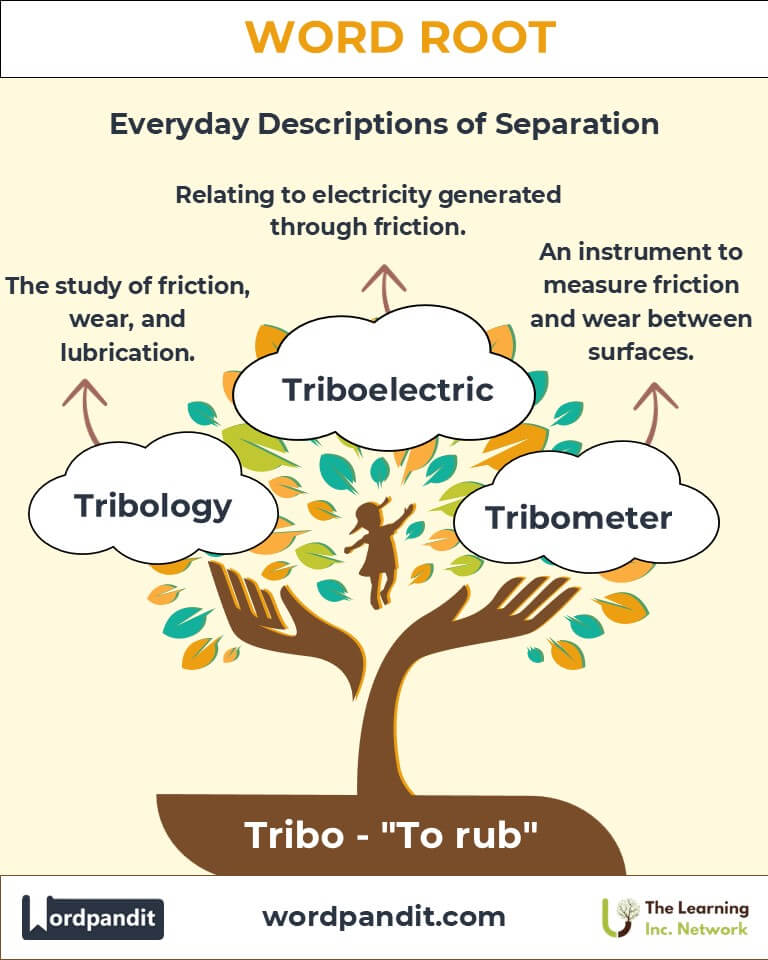Tribo: The Frictional Force Behind Modern Science and Innovation
Dive into the fascinating world of the word root "Tribo," derived from the Greek word tribein, meaning "to rub." This powerful root forms the foundation of words that describe the science of surfaces in contact and their resulting friction, wear, and lubrication. From "tribology" to "tribometer," tribo underpins some of the most critical concepts in engineering, physics, and material science.

Table of Contents
- Introduction: The Essence of Tribo
- Etymology and Historical Journey
- Mnemonic: Unlocking the Power of Tribo
- Common Tribo-Related Terms
- Tribo Through Time
- Tribo in Specialized Fields
- Illustrative Story: Tribo in Action
- Cultural Significance of Tribo
- The Tribo Family Tree
- FAQs about the Tribo Word Root
- Test Your Knowledge: Tribo Word Root Quiz
- Conclusion: The Living Legacy of Tribo
Introduction: The Essence of Tribo
Every time two surfaces come into contact, the principles of tribo come into play. Pronounced "try-bo," this Greek-derived root meaning "to rub" is foundational to understanding friction, wear, and lubrication. The study of tribology has revolutionized fields as diverse as automotive engineering and biomedical devices, making tribo essential to modern innovation.

Etymology and Historical Journey
The root tribo originates from the Greek verb tribein, meaning "to rub or wear away." Historically, ancient Greek philosophers and engineers first observed the effects of rubbing surfaces, leading to early theories of friction. During the Renaissance, tribology advanced as Leonardo da Vinci studied frictional forces. The term "tribology" itself was formalized in the 20th century, marking the emergence of a dedicated field that integrates engineering, materials science, and physics.
Mnemonic: Unlocking the Power of Tribo
Imagine two stones rubbing together, creating sparks and heat. This vivid image symbolizes the essence of tribo—interaction through contact and motion.
Mnemonic Device: "Tribo brings sparks to life, from rubbing stones to sliding innovations."
Common Tribo-Related Terms
- Tribology (try-bol-uh-jee): The study of friction, wear, and lubrication.
Example: "Advances in tribology have improved the lifespan of machine components." - Tribometer (try-bom-uh-ter): An instrument used to measure friction and wear between surfaces.
Example: "The lab tested the material's durability using a tribometer." - Triboelectric (try-bo-ee-lek-trik): Relating to electricity generated through friction.
Example: "Triboelectric effects power some modern wearable devices." - Tribulation (try-byoo-lay-shun): Suffering or distress, metaphorically linked to being "rubbed" by challenges.
Example: "Despite tribulations, she persevered and succeeded." - Attrition (uh-trish-uhn): The process of gradual wear caused by friction.
Example: "The attrition of the stone surface was evident after years of erosion."
Tribo Through Time
- Ancient Observations: Greek engineers noted the effects of friction in machinery, setting the foundation for tribological concepts.
- Renaissance Revolution: Leonardo da Vinci systematically studied friction, laying the groundwork for modern tribology.
- Modern Applications: Tribology today influences cutting-edge fields like nanotechnology and sustainable energy.
Tribo in Specialized Fields
- Engineering:
Tribology enhances the efficiency and durability of machinery by minimizing wear and energy loss. - Medicine:
Tribological coatings are applied to prosthetics and implants to reduce friction and improve longevity. - Energy:
Triboelectric generators harness friction to generate renewable energy for wearable technologies. - Aerospace:
Tribological studies are crucial for the development of materials that can withstand extreme conditions.
Illustrative Story: Tribo in Action
In a small engineering lab, Maya, a mechanical engineer, faced a challenge: her team’s wind turbine bearings wore out too quickly. By applying principles of tribology, she selected a new lubricant and adjusted the surface coatings. The result? A 40% increase in the turbine's efficiency. This success not only saved costs but also demonstrated the power of understanding tribo-based interactions.
Cultural Significance of Tribo
Beyond its technical applications, tribo symbolizes persistence and transformation. The metaphorical "friction" of life's challenges often leads to growth, just as physical rubbing polishes and refines surfaces. Cultural expressions, such as "trial by fire," echo the tribological principle of enduring and emerging stronger.

The Tribo Family Tree
- Fric- (Latin: "rub"):
- Term: Friction: The resistance encountered when one surface moves over another.
- Term: Refractory: Resistant to heat or wear.
- Attrit- (Latin: "rub against"):
- Term: Attrition: Gradual wearing down.
- Term: Contrite: Sincerely remorseful, as if "rubbed down" by guilt.
- Wear- (Old English: "to erode"):
- Term: Wear: To deteriorate through use.
- Term: Weariness: Physical or emotional erosion.
FAQs About " Tribo "
Q: What does the root "Tribo" mean?
A: "Tribo" comes from the Greek word tribein, meaning "to rub." It is commonly associated with friction, wear, and interaction between surfaces, as seen in the study of tribology.
Q: What is tribology?
A: Tribology is the science of friction, wear, and lubrication. It studies how surfaces interact under motion, aiming to improve the performance and durability of machines, tools, and everyday items.
Q: How does tribology benefit industries?
A: Tribology helps industries reduce energy consumption, enhance machine efficiency, and extend the lifespan of mechanical components. By understanding friction and wear, engineers can design better lubricants and materials to optimize performance.
Q: What are examples of tribology in daily life?
A: Examples include the friction of car tires on roads, wear of shoe soles, lubrication of engine parts, and even the study of joint movement in the human body. Tribology impacts everything from transportation to healthcare.
Q: What is triboelectricity?
A: Triboelectricity is the static electricity generated when two different materials are rubbed together, causing electrons to transfer. This phenomenon is the basis for devices like triboelectric nanogenerators, which convert friction into usable energy.
Q: What is the role of lubricants in tribology?
A: Lubricants reduce friction and wear between moving surfaces by forming a protective film. This minimizes energy loss and prevents damage, making lubrication a cornerstone of tribological studies.
Test Your Knowledge: " Tribo " Mastery Quiz
1. What does "Tribo" mean?
2. What does tribology study?
3. What is triboelectricity?
4. How do lubricants reduce wear?
5. Which is NOT an example of tribology in action?
Conclusion: The Living Legacy of Tribo
The root tribo represents more than just the physical act of rubbing—it embodies the principles of friction, wear, and transformation that drive innovation across disciplines. From ancient Greek observations to modern engineering breakthroughs, tribo continues to spark discoveries that shape our world. Let its enduring legacy inspire you to explore the frictions that drive progress.












